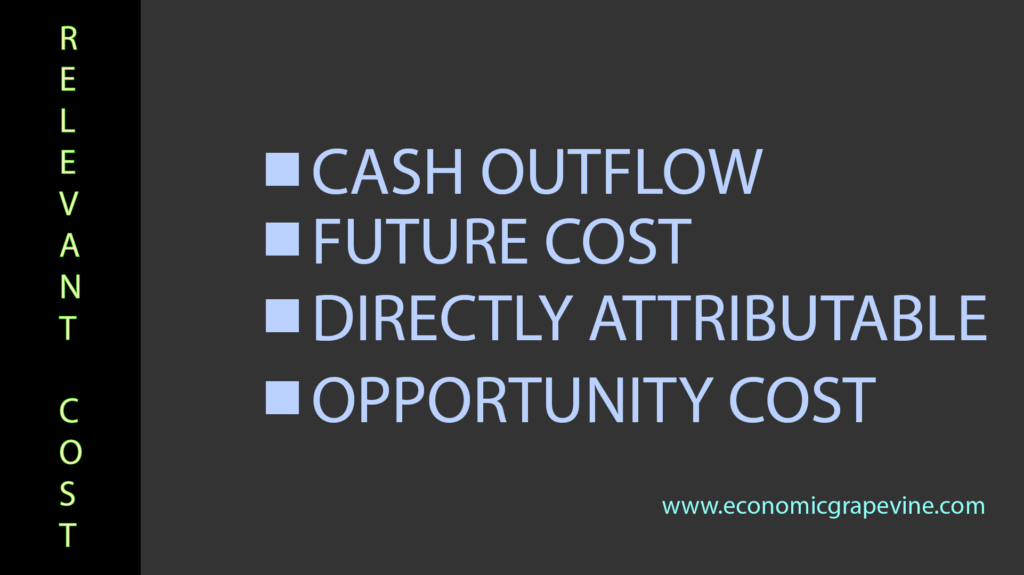Relevant Cost Definition
Relevant Cost is a concept of Managerial Accounting that facilitates the cost-benefit analysis. It makes the decision-making process easier by focusing on cash flows that are directly linked to the project or product and which could be avoided if the product or project is not proceeded with.
The Relevant cost can be defined as a future cash outflow that is directly linked to a product or project and which could be avoided if the product or project is not proceeded with. Specifically, relevant costs include the costs which the entity is going to incur due to the underlying project and if the entity does not select the project, these costs would be avoided.

Some basic relevant costs include incremental costs, future costs, opportunity costs, and other directly attributable costs. However, relevant costs may vary with the nature of the project or product.
As stated above, relevant cost is always a cash outflow and if the cost does not result in cash outflow (depreciation, etc), it will not be considered a relevant cost. In the same way, costs that have already been incurred (sunk costs) are not relevant as they have already been incurred and the business cannot do anything about it.
Here’s the list of costs that are irrelevant in terms of the relevant costing technique.
- Sunk Costs: Costs that have already been incurred.
- Committed Costs: Costs that will be incurred irrespective of the decision.
- Notional Costs: Imaginary costs included in the cost of product/investment for decision making purposes such as rent etc…
- Non-cash Expenses: Only cash expenses are considered relevant and ALL non-cash expenses are irrelevant such as depreciation.
Now that we know which costs are irrelevant, let’s look at how to categorize a relevant cost. If a cost has the following features, it will be considered relevant for decision-making.
- Future Costs: The cost will be incurred at some point in future and has not yet been incurred.
- Cashflow: The cost will result in cash outflow to the entity.
- Directly Atrributable: The cost can be directly attributed to the product/investment.
- Opportunity Cost: Opportunity cost is the sacrifice of an income unit or any other financial loss that results due to making a decision.

Difference Between Relevant & Irrelevant Cost
An irrelevant cost is the opposite of a relevant cost meaning that these are costs that are not directly related to the product or project. For example, if a business wants to manufacture a new product in the production center that the business already rents, then the rental cost is irrelevant for cost-benefit analysis of the product since the business will continue to pay the rent anyway.
In the same way, sunk costs, committed costs, notional costs, non-cash expenses, and unavoidable costs are irrelevant for cost-benefit analysis.
Why Relevant Cost Is Important?
Whenever a business plans to invest in a product or service, it performs the cost-benefit analysis of the underlying investment.
The cost-benefit analysis simply means an analysis that tells us whether the product or service is financially viable for the business and is done by comparing the cash inflows with the cash outflows.
As a rule of thumb, if the cash inflows exceed the cash outflows, the product is considered financially viable. However, the decision to select or reject potential products or services ultimately comes down to the business’ own policies.
So, which costs should be considered while analyzing the product or service? Every business incurs tens (hundreds at times) of costs and the selection criteria could become confusing. Therefore, to make the decision-making easier and neat, the relevant cost model is used.
The relevant cost model eliminates costs that are not related to the product or service and leaves us with the ones that we should consider for decision-making purposes. Hence, it gives us relevant costs for cost-benefit analysis.
In addition, the relevant cost model only considers the costs that have a direct impact on the underlying potential product or service, and the financial viability is judged fairly.
SUMMARY
Relevant Cost in managerial accounting means a cost that should be considered for decision-making purposes such as the cost-benefit analysis. These are costs that play a key role in the making of a product or any other investment decision. In simple terms, costs that are directly related to the product or service are called relevant costs.
The relevant cost model is used to eliminate unnecessary costs to make the decision-making process easier & fair. As a rule of thumb, a cost is relevant if it results in an inflow/outflow of cash, is a future cost, can be directly attributed to the product/service, or has an opportunity cost.
To solve an exam question on relevant costing, assess each cost and check whether the cost fulfils the above criteria. If it fulfils the criteria, you should consider the cost for decision-making purposes related to the product. If it does not fulfil the criteria, the cost will not be considered when performing the cost-benefit analysis of the product or service.
The relevant cost model is a very beneficial model in that it eradicates unnecessary costs and leaves us with related costs that have a direct link with the underlying product or investment. Therefore, it makes the decision-making process easier & fair.
